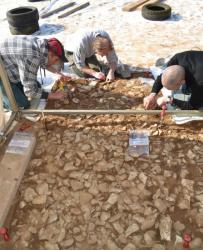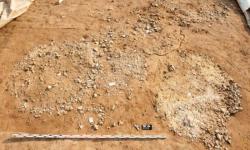- 19 AVRIL
- CHINE – Xi’an - Archaeologists have decided against opening a tomb in China's ancient capital of Xi'an and have instead turned their efforts to protecting relics discovered in a side chamber. "We found some lacquer and bamboo trunks in the tomb's side chamber, which was opened on Saturday afternoon," Zhang Zhongli, leader of the archaeological excavation team, was quoted as saying by Friday's China Daily. "And since the relics could be easily damaged when they were moved, we decided to close the side chamber again using plastic sheeting and the ancient bricks that had closed the chamber and to make a proper plan to better protect the relics." "We sprayed protective chemicals once every 3 hours after the side chamber had been opened," said Zhao Xichen, of Shaanxi archaeological research institute. The tomb was never plundered by robbers, making it the only one to have that distinction among the 14 tombs in the family cemetery of Zhang Anshi (?-62 BC), a famous general in the Western Han Dynasty.
http://www.kaogu.cn/en/detail.asp?ProductID=2778
- CHINE – Yibin - During the second-round of excavations at the Shizhudi graveyard in Yibin, the Sichuan Provincial Institute of Cultural Relics and Archaeology and other units recently discovered large-scale remnants of the Shang and Zhou dynasties. Archaeologists launched the first round of archaeological excavations from May to August 2010 and the excavation area has reached 2,000 square meters. The current excavations have lasted for several months. Archaeologists have explored an area of 2,000 square meters and cleared up more than 170 various sites. More than 500 various items, such as bronze ware, ironware, pottery and porcelain were unearthed from this area, including 59 various sites relating to the Shang and Zhou dynasties, such as ash pits, ash trenches, housing sites and tombs. A large number of pottery fragments were also unearthed in this area. Related officials said that the current archaeological excavations will provide important first-hand information for the research on the Qin and Han dynasties culture exchanges in southern Sichuan and the Jinshajiang River basin.
http://www.kaogu.cn/en/detail.asp?ProductID=2774
- FRA NCE –  Sornay - Le chantier de fouilles qui s’est ouvert au début du mois d’avril à Sornay, entre Pesmes et Marnay (70), n’est effectivement pas spectaculaire. Le rectangle de terrain étudié tout près de la mairie et de l’école laisse simplement apparaître une nébuleuse de trous plus ou moins gros, correspondant d’après leurs positions à des creusements et points d’appui de poteaux de bâtiments et d’aménagements s’échelonnant du V e au X e siècle (le haut Moyen-Âge). Ils permettent de remonter vers les origines du village.
Sornay - Le chantier de fouilles qui s’est ouvert au début du mois d’avril à Sornay, entre Pesmes et Marnay (70), n’est effectivement pas spectaculaire. Le rectangle de terrain étudié tout près de la mairie et de l’école laisse simplement apparaître une nébuleuse de trous plus ou moins gros, correspondant d’après leurs positions à des creusements et points d’appui de poteaux de bâtiments et d’aménagements s’échelonnant du V e au X e siècle (le haut Moyen-Âge). Ils permettent de remonter vers les origines du village.
http://www.estrepublicain.fr/fr/l-est-en-franche-comte/vesoul-et-ses-environs/24-heures-haute-saone/info/4957276-Sornay-%28Haute-Saone%29-un-village-de-1500-ans
- BELGIQUE – 
 Petit Spiennes - Depuis début mars 2011, des fouilles préventives sont organisées par le Service public de Wallonie à l’emplacement du futur bâtiment d’accueil des visiteurs des Minières néolithiques de silex de Spiennes- L’intervention archéologique a permis la mise au jour d’ateliers de taille remarquablement conservés dont une partie sera préservée in situ dans le pavillon des visiteurs. Les parties, qui à terme ne pourront pas être maintenues en place, sont soigneusement dégagées et prélevées (image 1). Les archéologues s’attellent aussi à nettoyer, photographier et relever les puits d’extraction du silex mis au jour. Certains seront en partie fouillés. D’autres, situés à l’extérieur de l’emprise du bâtiment, vont être préservés et les zones décapées pourront à terme être remblayées (image 2). Outre les vestiges néolithiques, bien connus dans ce secteur, les fouilles ont révélé à l’intérieur de l’emprise la présence d’un large fossé de 8 m faisant très certainement partie du système de défense des Lignes de la Trouille, mis en œuvre sous Louis XIV. Ce vaste système défensif est notamment visible sur plusieurs vues aériennes entre la frontière française actuelle et Mons.
Petit Spiennes - Depuis début mars 2011, des fouilles préventives sont organisées par le Service public de Wallonie à l’emplacement du futur bâtiment d’accueil des visiteurs des Minières néolithiques de silex de Spiennes- L’intervention archéologique a permis la mise au jour d’ateliers de taille remarquablement conservés dont une partie sera préservée in situ dans le pavillon des visiteurs. Les parties, qui à terme ne pourront pas être maintenues en place, sont soigneusement dégagées et prélevées (image 1). Les archéologues s’attellent aussi à nettoyer, photographier et relever les puits d’extraction du silex mis au jour. Certains seront en partie fouillés. D’autres, situés à l’extérieur de l’emprise du bâtiment, vont être préservés et les zones décapées pourront à terme être remblayées (image 2). Outre les vestiges néolithiques, bien connus dans ce secteur, les fouilles ont révélé à l’intérieur de l’emprise la présence d’un large fossé de 8 m faisant très certainement partie du système de défense des Lignes de la Trouille, mis en œuvre sous Louis XIV. Ce vaste système défensif est notamment visible sur plusieurs vues aériennes entre la frontière française actuelle et Mons.
http://www.minesdespiennes.org/blog/2011/avril-2011-fouilles-preventives-de-petit-spiennes/
- MONGOLIE - This year marks the 2220th Anniversary of the first Hunnu State. Tengis Movie Theater and the Institute of Archaeology of the Mongolian Academy of Sciences are co-organizing an exhibition called “Hunnu State-2220”- The exposition was opened at the Tengis Movie Theater on April 15th. There are more than 100 rare findings which are being exhibited on this occasion. Various gold, silver and daubing plates and bronze findings made 2000 year ago are on the display. The Hunnu State was established in the year – 209 B.C. The Hunnu State was also the first state which was formed among the nomadic people of central Asia. There are so many archaeological discoveries and 16 remains of Hunnu Ages towns in Mongolia.
http://ubpost.mongolnews.mn/index.php?option=com_content&task=view&id=6090&Itemid=43
- CANADA –  Toronto - Relics of Toronto’s 19th-century railway boom, when train links began to turn the city into an industrial powerhouse, have been unearthed near Fort York. Brick and masonry foundation walls uncovered by archaeologists are the remains of a huge cruciform-shaped engine-house complex built by the Grand Trunk Railway in the 1850s. These buildings, near the shore of Lake Ontario, marked the starting point of the railway’s westbound ribbon of track. According to railway historian Derek Boles, Toronto was basically a warehousing centre until the mid-19th century. The railways turned it into a manufacturing hub and “having an appreciation for that background is really important for understanding Toronto’s history,” he said. Preliminary archaeological work on the site about four years ago revealed evidence of ruins, and historic maps indicated the developers could expect to find some parts of the engine house structure. The dig was organized to determine what would need to be dealt with before construction began. Some intact portions of the engine house had been found, including 2.5-metre-high foundation walls consisting of 15 layers of stone, and some timbers that supported the floors. The site was earlier occupied by a blockhouse, built in the late 1790s, that was part of the Fort York complex. But any remnants of that building were likely destroyed when the railway property was developed decades later. The Grand Trunk Railway built the large engine house, which included a turntable, smithy, pump house and temporary passenger terminal, as part of its efforts to compete in the market for travel to the Midwest United States. The Grand Trunk had a separate line that ran to Eastern Canada, Mr. Boles said, but its terminus was three kilometres further east near the Don Valley. For several months in the mid-1850s, until the two lines were linked by rail, connecting passengers had to take a horse-drawn omnibus between the terminals.
Toronto - Relics of Toronto’s 19th-century railway boom, when train links began to turn the city into an industrial powerhouse, have been unearthed near Fort York. Brick and masonry foundation walls uncovered by archaeologists are the remains of a huge cruciform-shaped engine-house complex built by the Grand Trunk Railway in the 1850s. These buildings, near the shore of Lake Ontario, marked the starting point of the railway’s westbound ribbon of track. According to railway historian Derek Boles, Toronto was basically a warehousing centre until the mid-19th century. The railways turned it into a manufacturing hub and “having an appreciation for that background is really important for understanding Toronto’s history,” he said. Preliminary archaeological work on the site about four years ago revealed evidence of ruins, and historic maps indicated the developers could expect to find some parts of the engine house structure. The dig was organized to determine what would need to be dealt with before construction began. Some intact portions of the engine house had been found, including 2.5-metre-high foundation walls consisting of 15 layers of stone, and some timbers that supported the floors. The site was earlier occupied by a blockhouse, built in the late 1790s, that was part of the Fort York complex. But any remnants of that building were likely destroyed when the railway property was developed decades later. The Grand Trunk Railway built the large engine house, which included a turntable, smithy, pump house and temporary passenger terminal, as part of its efforts to compete in the market for travel to the Midwest United States. The Grand Trunk had a separate line that ran to Eastern Canada, Mr. Boles said, but its terminus was three kilometres further east near the Don Valley. For several months in the mid-1850s, until the two lines were linked by rail, connecting passengers had to take a horse-drawn omnibus between the terminals.
http://www.theglobeandmail.com/news/national/toronto/railway-relics-unearthed-at-site-of-condo-project/article1990440/
- ROYAUME-UNI –  Finsbury - Experts have discovered tiles and pottery which are hundreds of years old while examining the grade-two listed facility in Ironmonger Row, Finsbury. The biggest surprise has been the fact the archaeology has survived under the basement of the bath house- Archaeologists have unearthed a glazed and decorated medieval floor tile which dates back to before 1390 . They have also found pottery dated to 1480-1550 and a patch of clay which contains decorated English pottery from a period between 1170 and 1350. The investigation has also pinpointed the location of a medieval manor house which belonged to St Luke’s Church. The Ironmonger Row Baths was turned into a bathing venue in 1931 and later upgraded to Turkish baths. There were terraced houses on the site from the 18th century.
Finsbury - Experts have discovered tiles and pottery which are hundreds of years old while examining the grade-two listed facility in Ironmonger Row, Finsbury. The biggest surprise has been the fact the archaeology has survived under the basement of the bath house- Archaeologists have unearthed a glazed and decorated medieval floor tile which dates back to before 1390 . They have also found pottery dated to 1480-1550 and a patch of clay which contains decorated English pottery from a period between 1170 and 1350. The investigation has also pinpointed the location of a medieval manor house which belonged to St Luke’s Church. The Ironmonger Row Baths was turned into a bathing venue in 1931 and later upgraded to Turkish baths. There were terraced houses on the site from the 18th century.
http://www.islingtongazette.co.uk/news/history_is_uncovered_in_work_on_finsbury_baths_facelift_1_869402